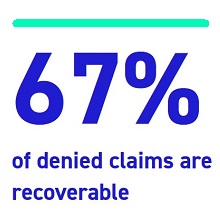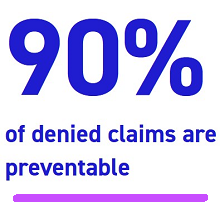Knowing When and How to Fight the Good FightBy Tiffany Ferguson, LMSW, CMAC, ACM and Denise Wilson MS, RN, RRT | March 20, 2023
The need for benchmarking denials is evident as there are variations in hospital appeal processes.
The c-suites of hospital organizations are often in a quest to benchmark their data against other health systems to see if a particular area is a legitimate concern, particularly when it comes to financial metrics such as denials.
Although it bears noting that such benchmarks are based on the specific organization’s set of reporting definitions, which can vary by internal practices and definition interpretations. The Healthcare Financial Management Association (HFMA) Claim Integrity Task Force has made significant strides to address this variation by providing standardized definitions and calculations for denials.
Despite such standard definitions, variation often still resides in the decisions made among the frontline employees, creating subjectivity for what is defined as a true denial. One often problematic area is the internal discrepancies in how a denial is categorized, and another is decisions made by appeal representatives when they decide what should be written off, how things are categorized, and what should be appealed.
When the business office receives notification of a denial, it typically comes in one of two ways; one is a remittance code provided on the returned claim. The remittance code is selected either automatically by the payer’s system, or it is entered manually by someone on the payer side, depending on the code and the sophistications of their technology. Once the claim is returned to the billing office, they will review it and see if this was a kickback because of an error, meaning that the claim went out with something missing that requires simple correction, or if the claim is being partially or fully denied. At that point, either the biller or technology within the billing software will correct the error and resubmit. If they are unable to do this, they will review the claim and make a decision internally on what should be adjusted as contractual, or if this is a denial. In concert with this process, if the claim is being denied, the payer will also send a letter with justification for the denial. This letter and the confirmed lack of payment then is managed by an appeal representative.
Appealing the Denial
Again, this practice is also widely variable across healthcare organizations because of hospital size, denial team structure, and if the denial and appeal work is completed internally, outsourced, or a hybrid. When the denial is reviewed by the appeal individual/ team, there is also another decision point. The hospitals all take variable approaches at this point, asking themselves how many denials they will fight, and up to which level? What dollar amounts are worth fighting for, and when should the denial be written off? Based on all these variables, CFOs looking for benchmarking should really understand their internal processes and definitions before they question their denial performance in the marketplace.
AHDAM Recommendation
The Association of Healthcare Denial and Appeal Management (AHDAM) has a great process for evaluating denials. This process involves a simple question: “What is the likelihood of overturning this denial on appeal?” They recommend an internal tracking mechanism called an “appealability score.” Although the tool is slightly subjective, what it forces the appealer to say is, “based on the review of this case, guidelines for evaluation, and the documentation, what is the likelihood that this denial will be overturned if I appeal?” By asking this question and applying a score, denials are placed in two categories: internal opportunities for the organization, and external opportunities with the payer. This score is then documented on each review and tracked in the denial metrics data against key performance indicators (KPIs).
For example, by applying this mechanism, cases that were still denied by the payer that nonetheless have a high appealability (winnability) score could then be aggregated, providing a justifiable case to discuss in payer-hospital joint meetings, or even to submit it for arbitration. Appealability score criteria should be made as neutral as possible so that fair comparisons can be made among payers.
Organizations that apply an appealability score will likely have a higher win rate on their appeals because they internally made a decision on what they knew was worth fighting for. This is compared to other hospitals that have decided to fight everything, knowing full well that they will not win them all. The concern with this effort is the number of internal people and amount of time it takes to fight claims when the payer was likely justified for not paying the hospital (and it lacks an opportunity to create an internal structure for denial prevention). If the healthcare organization instead decides to identify their “low-appealability” cases for internal review, they can subcategorize these by accountability owners and reasons to create improved processes to prevent the denials from even occurring in the first place. Tiffany Ferguson, LMSW, CMAC, ACMTiffany Ferguson is CEO of Phoenix Medical Management, Inc., the care management company. Tiffany serves on the ACPA Observation Subcommittee. Tiffany is a contributor to RACmonitor, Case Management Monthly, and commentator for Finally Friday. After practicing as a hospital social worker, she went on to serve as Director of Case Management and quickly assumed responsibilities in system level leadership roles for Health and Care Management and c-level responsibility for a large employed medical group. Tiffany received her MSW at UCLA. She is a licensed social worker, ACM, and CMAC certified.
|
Quick Links
Latest News
- Healthcare Finance: Many payers, providers unprepared for interoperability and prior authorization rule, WEDI finds
- Healthcare Finance: Bill would allow physicians to make prior authorization judgments
- Becker's: States consider crackdowns on AI in prior authorization
- Healthcare Finance: Optum Rx announces a reduction in drug prior authorization
- ABC: Struggling for Survival: How one patient overcame insurance denials for critical blood transfusions
8600 La Salle Road, Suite 625, Towson, Maryland 21286
[email protected]
© Copyright 2024, Association for Healthcare Denial and Appeal Management (AHDAM)




